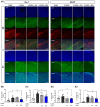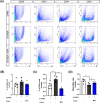Stimulation of microneedles alleviates pathology of Parkinson's disease in mice by regulating the CD4+/CD8+ cells from the periphery to the brain
- PMID: 39628485
- PMCID: PMC11611716
- DOI: 10.3389/fimmu.2024.1454102
Stimulation of microneedles alleviates pathology of Parkinson's disease in mice by regulating the CD4+/CD8+ cells from the periphery to the brain
Abstract
Introduction: Immune dysfunction is a major cause of neuroinflammation and accelerates the progression of Parkinson's disease (PD). Numerous studies have shown that stimulation of specific acupuncture points (acupoints) can ameliorate PD symptoms. The purpose of this study was to investigate whether attaching microneedles to acupoints would improve PD pathology by recovering immune dysfunction.
Methods: The PD mouse model was induced by intrastriatal injection of 6-hydroxydopamine (6-OHDA), and microneedle patches (MPs) or sham patches (SPs) were attached to GB20 and GB34, representative acupoints for treating PD for 14 days.
Results: First, the behavioral experiment showed that motor disorders induced by 6-OHDA were significantly improved by MP. Simultaneously, 6-OHDA-induced dopaminergic neuronal death and brain neuroinflammation decreased. Conversely, SP had no effect on behavioral disorders, neuronal death, or neuroinflammation. Measurement results from flow cytometry of immune cells in the brain and blood revealed a disruption in the CD4+/CD8+ ratio in the 6-OHDA group, which was significantly restored in the MP group. The brain mRNA expression of cytokines was significantly increased in the 6-OHDA group, which was significantly decreased by MP.
Discussion: Overall, our results suggest that the attachment of MPs to GB20 and GB34 is a new method to effectively improve the pathology of PD by restoring peripheral and brain immune function.
Keywords: Parkinson’s disease; acupuncture point; microneedle; neuroinflammation; peripheral immune.
Copyright © 2024 Kim, Choi, Kim, Lee, Ju, Yoo, La, Jeong, Na, Park and Oh.
Conflict of interest statement
Authors NYY, SL, and DHJ were employed by the company Raphas Co. Ltd. The remaining authors declare that the research was conducted in the absence of any commercial or financial relationships that could be construed as a potential conflict of interest.
Figures







References
MeSH terms
Substances
LinkOut - more resources
Full Text Sources
Medical
Research Materials

